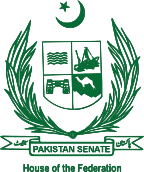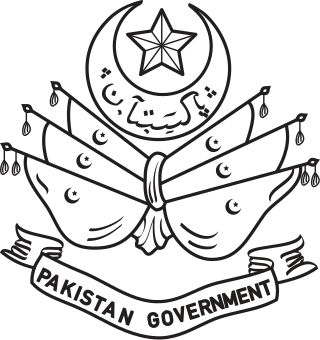Related Research Articles

A constituent assembly is a body assembled for the purpose of drafting or revising a constitution. Members of a constituent assembly may be elected by popular vote, drawn by sortition, appointed, or some combination of these methods. Assemblies are typically considered distinct from a regular legislature, although members of the legislature may compose a significant number or all of its members. As the fundamental document constituting a state, a constitution cannot normally be modified or amended by the state's normal legislative procedures in some jurisdictions; instead a constitutional convention or a constituent assembly, the rules for which are normally laid down in the constitution, must be set up. A constituent assembly is usually set up for its specific purpose, which it carries out in a relatively short time, after which the assembly is dissolved. A constituent assembly is a form of representative democracy.

The Senate of Pakistan or Aiwān-e-Bālā Pākistān, constitutionally the House of the Federation, is the upper house of the bicameral Parliament of Pakistan. As of 2023, It has a maximum membership of 100, of which 92 are elected by the provincial legislatures using single transferable vote. Four represent the Federal Capital and another four are representing former Federally Administered Tribal Areas, until membership expiration in 2024. Members sit for terms lasting six years, with half of the house up for election every three years. Unlike the National Assembly, the Senate is a continuing chamber and hence not subject to dissolution.

The National Assembly of Pakistan is the lower house of the bicameral Parliament of Pakistan, with the upper house being the Senate. As of 2023, the National Assembly has a maximum membership of 342, of which 266 are directly elected by an adult universal suffrage and a first-past-the-post system to represent their respective constituencies, while 70 are elected on reserved seats for women and religious minorities from all over the country and six on reserved seats for former Federally Administered Tribal Areas, and the members hold their seats for five years or until the house is dissolved by the President on the advice of the Prime Minister. The house convenes at the Parliament House, Red Zone, Islamabad.

The Parliament of Pakistan is the supreme legislative body of the Islamic Republic of Pakistan. It is a bicameral federal legislature, composed of the President of Pakistan and two houses: the Senate and the National Assembly. The president, as head of the legislature, has the power to summon or prorogue either house of the Parliament. The president can dissolve the National Assembly, only on the Prime Minister's advice.

The Constituent Assembly of India was elected to frame the Constitution of India. It was elected by the 'Provincial Assembly'. Following India's independence from the British rule in 1947, its members served as the nation's first Parliament as the 'Provisional Parliament of India'.

The Constituent Assembly of Pakistan was established in August 1947 to frame a constitution for Pakistan. It also served as its first interim parliament. It was dissolved by the Governor-General of Pakistan in 1954.

The Speaker of the National Assembly ; informally as Speaker National Assembly, is the presiding official of the National Assembly of Pakistan– a lower house of the Parliament of Pakistan.
The Objectives Resolution was adopted by the Constituent Assembly of Pakistan on March 12, 1949. The resolution proclaimed that the future constitution of Pakistan would not be modeled entirely on a European pattern, but on the ideology and democratic faith of Islam. The resolution, in its entirety, has been made part of the Constitution of Pakistan under Article 2(A).

The East Pakistan Provincial Assembly, known as the East Bengal Legislative Assembly between 1947 and 1955, was the provincial legislature of East Pakistan between 1947 and 1971. It was known as the East Bengal Assembly from 1947 to 1955 when the provincial name was changed. The legislature was a successor to the Bengal Legislative Council and the Bengal Legislative Assembly, which were divided between East Bengal and West Bengal during the partition of Bengal in 1947. It was the largest provincial legislature in Pakistan. Elections were held only twice in 1954 and 1970.
The Dominion of Pakistan was founded in 1947 as a result of the independence of India from British rule, when India was simultaneously partitioned to create Pakistan. East Pakistan seceded in 1971 as a result of the Language Movement followed by the Bangladesh War of Independence, and West Pakistan has continued the Pakistani national identity since. Pakistan is a member of the Commonwealth of Nations.

The history of East Bengal and East Pakistan from 1947 to 1971 covers the period of Bangladesh's history between its independence as a part of Pakistan from British colonial rule in 1947 to its independence from Pakistan in 1971.

The Pakistan National Congress (PNC), later known as the Bangladesh National Congress, was a political party that mainly represented the Hindus, Christians and other religious minorities in Pakistan. The party championed secularism in the Muslim-dominated state, and its electoral and organisational strength was mainly based in East Bengal.
The Constitution of 1956 was the fundamental law of Pakistan from March 1956 until the 1958 Pakistani coup d'état. It was the first constitution adopted by independent Pakistan. There were 234 articles 13 parts and 6 schedules.

The Basic Principles Committee (BPC) was a specialized committee set up in March 1949 by Khawaja Nazimuddin on the advice of prime minister Liaquat Ali Khan. The committee's sole purpose was to determine the basic underlying principles that would determine future constitutions and legislature in Pakistan.

From 1947 to 1956, the Dominion of Pakistan was a self-governing country within the Commonwealth of Nations that shared a monarch with the United Kingdom and the other Dominions of the Commonwealth. The monarch's constitutional roles in Pakistan were mostly delegated to a vice-regal representative, the governor-general of Pakistan.

The Constituent Assembly of Bangladesh was the constituent assembly of Bangladesh. It was the country's provisional parliament between 1971 and 1973. In 1972, it drafted and adopted the Constitution of Bangladesh. The assembly was dominated by the Awami League, with a minority being independent lawmakers.
Birat Chandra Mandal was a member of the 1st National Assembly of Pakistan as a representative of East Pakistan. He had argued for the constitution of Pakistan to be secular.
Siris Chandra Chattopadhyaya was a Bengali civil servant and politician from East Bengal. He was a Member of the 1st National Assembly of Pakistan as a representative of East Pakistan. He was born in Dhaka.
Muhammad Abdullah al-Baqi was a Bengali Islamic scholar, writer and politician. As a member of the Central Legislative Assembly, he played an active role in the Indian independence movement. He was a prominent leader of the Ahl-i Hadith movement in North Bengal, and played a significant roles in pre-partition Ahl-i Hadith conferences.
References
- ↑ Rehman, I. A. (10 September 2015). "In praise of dissent". Dawn .
- ↑ Parveen, Kausar. "The Role of Opposition in ConstitutionMaking: Debate on the Objectives Resolution" (PDF). Retrieved 23 February 2022.
- ↑ The Constituent Assembly (Legislature) of Pakistan Debate: Official Report. Manager of Publications. 1954. Retrieved 25 April 2020.
- ↑ Zaman, Muhammad Qasim (2018). Islam in Pakistan: A History. Princeton University Press. p. 57. ISBN 978-0-691-14922-6.